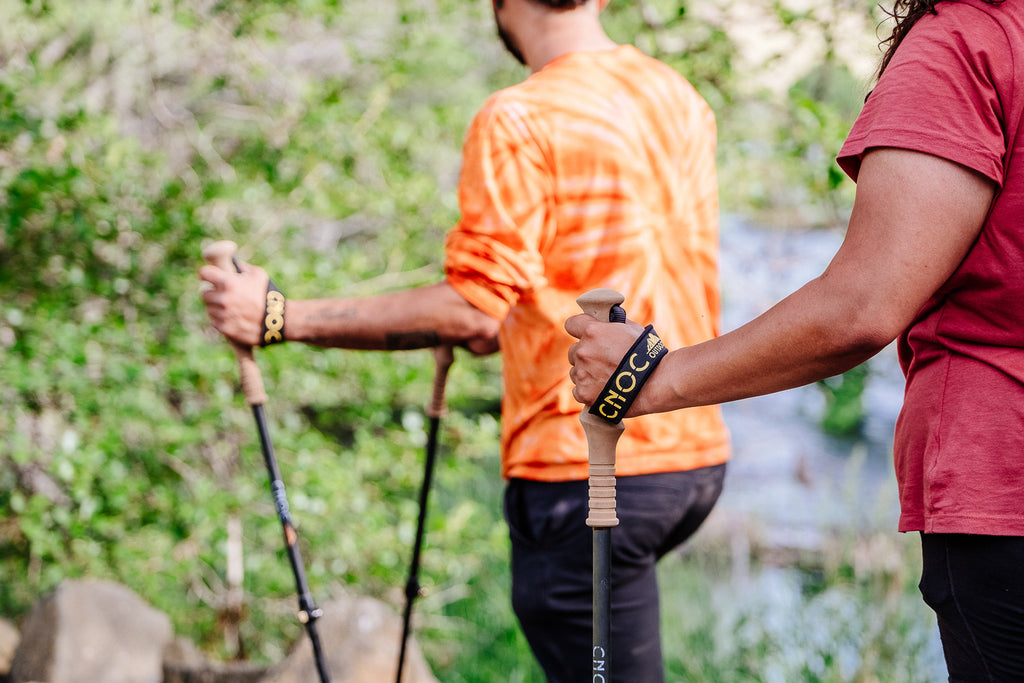Once and for All: Cork or EVA Handle?

Written by Gilad Nachmani - Founder of Cnoc Outdoors
2023 note: The sale of our trekking poles has moved over to our new brand Diorite Gear.
Over the last couple of months, it has been interesting to dissect and critically look at our Vertex poles as part of our redesign and moving production to the USA. One of the questions I've been hearing a lot is: why do you want to make a cork handle for your poles? This is a funny question since I originally only designed the Vertex to have an EVA handle, but repeated requests for a cork handle convinced me there is interest, so we made a cork version.
Since now the question of cork and EVA has come up again, I thought that maybe it is time to address it publicly, in a post. Many times, on a blog post or article about trekking poles, the handle question will be glossed over with a quick pro and con list. Naturally, I have a bit more of an in depth look at the grip question as the decision of what to make is even more complex than what to use.

Personally, I (Gilad) use foam (specifically EVA) grips on my poles. I have done so for over 10 years now after starting with cork, and I will never go back. I hear a lot that it is a matter of preference (which is probably true), but in all reality, I really believe EVA is just so much better than cork in every way, especially when it comes to performance.
So let's dive into the whole world of grips a bit more:
Cork
Material overview
Cork is a natural material; more specifically, it is a layer of internal bark of a specific species of oak. While light and buoyant, it is hydrophobic and impermeable, meaning it will not absorb any liquids such as sweat or rain.
The last great feature (that is worth mentioning for grips) is that it is elastic, and therefore tends to form into specific shapes with pressure.
Cork as grips for poles
The use of grips for poles started with fishing rods - the lightness and hydrophobic nature meant they would float while staying dry when fishing. The idea worked well and seasoned fishers found that the grip started to take the shape of their hands over time, which made them more comfortable.
The use of cork for trekking poles came as an alternative to the original rubber handles and proved comfortable, light and soft.
Foam (specifically EVA)
Material Overview
EVA (or Ethylene-vinyl acetate) is a polymer that can be made in a variety of ways based on the ratio of Ethylene-vinyl to Acetate. When it comes to what we want to look at, EVA is made in a foam form with a high ratio of VA, making it firm (compared to low VA, which is what makes cling-film).
EVA creates a material that is light and strong, with a high crack and abrasion resistance. As a foam, it is hydrophilic but dries extremely fast. It is soft yet holds its original form over time.
EVA as grips for poles
EVA was introduced and grips for lightweight (aluminum made) poles fairly quickly as it is light and strong. I can't find which were the first poles that used EVA foam but since they started as a technical item, you can expect that they were first used by mountaineers.
EVA foam came as a replacement to the sticky, heavy and uncomfortable rubber grips of the past by offering a light and comfortable alternative.
Cork or EVA, the reality
You might be a real believer that cork handles are great, that they feel comfortable and "don't sweat", but in reality, they are an out of date technology. Nature did a great job of showing us the ropes by making cork, and we made EVA foam based on what we learned.
EVA is lighter than cork, less abrasive, retains its shape, tends to deteriorate slower, feels warmer to the hands and is much cheaper to make. In terms of specifications and the needs of a hiker, there is no reason to use cork. But, as with all things we use, you are the one to decide, so the Vertex will continue to have a cork handle version.
In case you wondered, our new, USA Made, telescopic poles also come in EVA or Cork, just pick yours.











Seems everyone is pushing cork but I have heard that animals like to eat it. I decided that the EVA was more comfortable anyway.
As a beginner trying to decide what Nordic walking poles to purchase now I’m really confused.
As a 35+ year veteran hiker, your “reality”, as it pertains to EVA vs. Cork, and mine diverge. “In terms of specifications and the needs of a hiker, there is no reason to use cork.” As you have chosen to define them, maybe not, but I would disagree with some of your assertions. To me, “Feels warmer to the hand”, “retains it’s shape” and, “less abrasive” are not desireable attributes. Cork stays cooler in warm temps, “breaking in” a cork handle to conform to the users grip increases comfort, confidence and the abrasive nature of cork allows for a more secure grip in cold/wet conditions. EVA is cheaper and deteriorates slower… I’ll give you that. Kudos though for listening and catering to your customer base.
I’ve always used the EVA handles on my trekking poles. I have watched the cork handles peel from the handles of poles owned by several of my friends. I’ve never had that problem with my poles and they are over 20 years old.
Cork…Much more comfortable and is a natural material..
Leave a comment